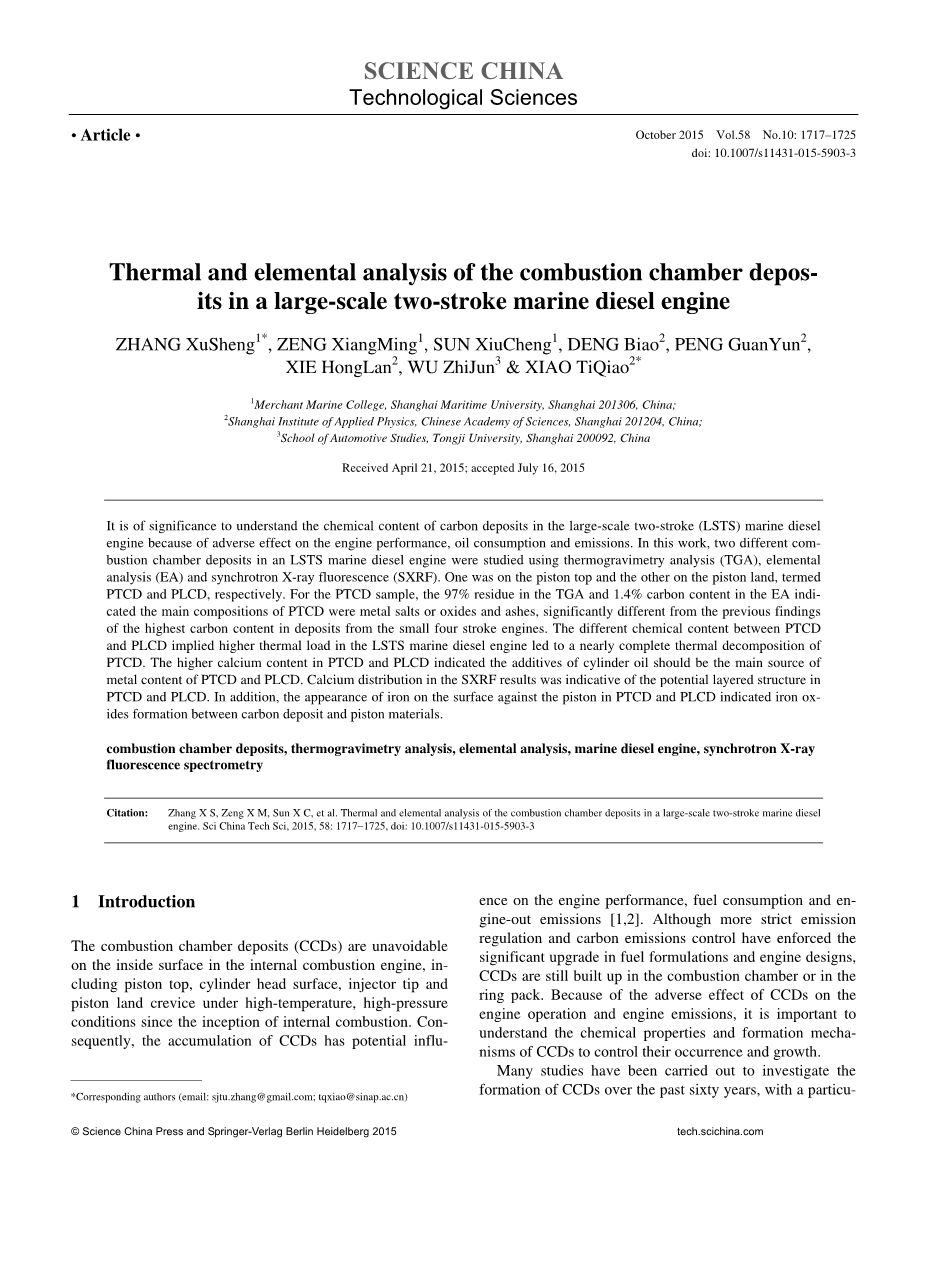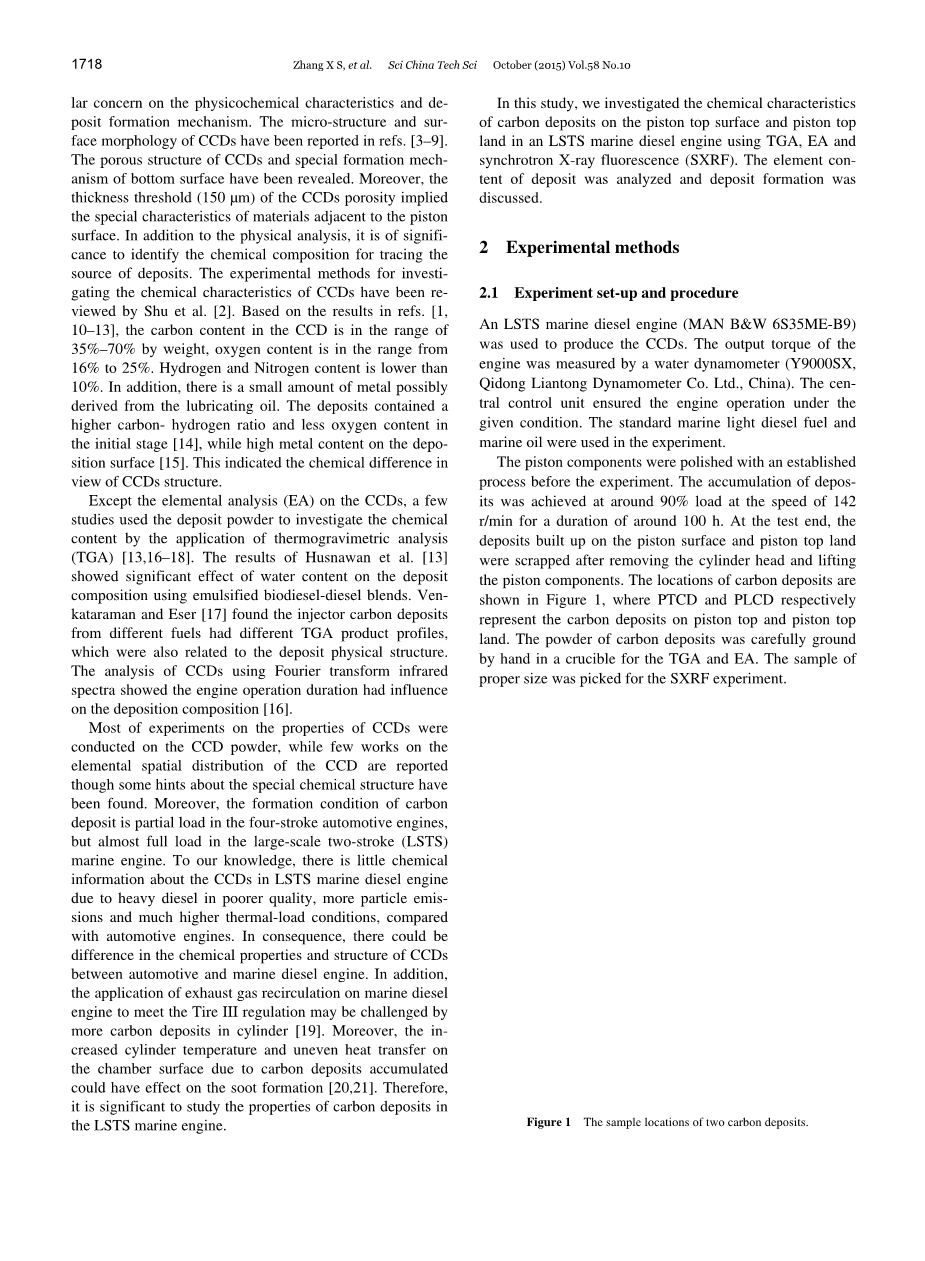大型二冲程柴油机燃烧室沉积的热分析外文翻译资料
2022-09-24 10:24:02


英语原文共 9 页,剩余内容已隐藏,支付完成后下载完整资料
Thermal and elemental analysis of the combustion chamber deposits in a large-scale two-stroke marine diesel engine
大型二冲程柴油机燃烧室沉积的热分析
ZHANG XuSheng1*, ZENG XiangMing1, SUN XiuCheng1, DENG Biao2, PENG GuanYun2,
XIE HongLan2, WU ZhiJun3 amp; XIAO TiQiao2
1Merchant Marine College, Shanghai Maritime University, Shanghai 201306, China;
上海海事大学商船学院,上海2013年6月,中国;
2Shanghai Institute of Applied Physics, Chinese Academy of Sciences, Shanghai 201204, China
中国科学院上海应用物理研究所,上海2012年4月,中国
3School of Automotive Studies, Tongji University, Shanghai 200092, China
同济大学汽车研究所,上海2000年9月2日,中国
Received April 21, 2015; accepted July 16, 2015
It is of significance to understand the chemical content of carbon deposits in the large-scale two-stroke (LSTS) marine diesel engine because of adverse effect on the engine performance, oil consumption and emissions. In this work, two different combustion chamber deposits in an LSTS marine diesel engine were studied using thermogravimetry analysis (TGA), elemental analysis (EA) and synchrotron X-ray fluorescence (SXRF). One was on the piston top and the other on the piston land, termed PTCD and PLCD, respectively. For the PTCD sample, the 97% residue in the TGA and 1.4% carbon content in the EA indicated the main compositions of PTCD were metal salts or oxides and ashes, significantly different from previous findings the of the highest carbon content in deposits from the small four stroke engines. The different chemical content between PTCD and PLCD implied higher thermal load in the LSTS marine diesel engine led to a nearly complete thermal of PTCD. The higher calcium content in PTCD and PLCD indicated the additives of cylinder oil should be the main source of metal content of PTCD and PLCD. Calcium distribution in the SXRF results was indicative of the potential layered structure in PTCD and PLCD. In addition, the appearance of iron on the surface against the piston in PTCD and PLCD indicated iron oxides formation between carbon deposit and piston materials.
了解大型二冲程船舶柴油机中积炭的化学成分是十分必要的,因其会对发动机的运行、耗油量和排放产生副作用。在研究中,LSTS柴油机中两种不同的燃烧室沉淀物——PTCD、PLCD,分别位于活塞头上与活塞环区,被应用热重分析(TGA)、元素分析(EA)和同步辐射X射线荧光分析(SXRF)进行了检测。在PTCD样本中,TGA检测所得97%的残渣和EA检测所得1.4%的含碳量表明了PTCD主要成分是金属盐或者氧化物和灰分,明显与之前研究表明小型四冲程柴油机沉淀有最高碳含量不同。PTCD和PLCD中不同的化学含量意味着在LSTS柴油机中较高的热负荷使得PTCD得以几乎完全热分解。PTCD和PLCD中高的钙含量表明PTCD和PLCD中金属化合物的主要来源应是汽缸油的添加剂。SXRF结果表明在PTCD和PLCD中钙分布有潜在的分层结构。此外,对着活塞的表面有铁的出现说明在积炭和活塞材料之间形成铁化合物。
combustion chamber deposits, thermogravimetry analysis, elemental analysis, marine diesel engine, synchrotron X-ray fluorescence spectrometry
燃烧室沉淀物, 热重分析,元素分析和同步辐射X射线荧光分析
Citation: Zhang X S, Zeng X M, Sun X C, et al. Thermal and elemental analysis of the combustion chamber deposits in a large-scale two-stroke marine diesel engine. Sci China Tech Sci, 2015, 58: 17171725, doi: 10.1007/s11431-015-5903-3
1 Introduction
The combustion chamber deposits (CCDs) are unavoidable on the inside surface in the internal combustion engine, including piston top, cylinder head surface, injector tip and piston land crevice under high-temperature, high-pressure conditions since the inception of internal combustion .Consequently, the accumulation of CCDs has potential influence on the engine performance, fuel consumption and engine-out emissions [1,2]. Although more strict emission
regulation and carbon emissions control have enforced the significant upgrade in fuel formulations and engine designs, CCDs are still built up in the combustion chamber or in the ring pack. Because of the adverse effect of CCDs on the engine operation and engine emissions, it is important to understand the chemical properties and formation mechanisms of CCDs to control their occurrence and growth. Many studies have been carried out to investigate the formation of CCDs over the past sixty years, with a particular concern on the physicochemical characteristics and deposit formation mechanism. The micro-structure and surface morphology of CCDs have been reported in refs. [3–9]. The porous structure of CCDs and special formation mechanism of bottom surface have been revealed. Moreover, the thickness threshold (150 mu;m) of the CCDs porosity implied the special characteristics of materials adjacent to the piston surface. In addition to the physical analysis, it is of significance to identify the chemical composition for tracing the source of deposits. The experimental methods for investigating
the chemical characteristics of CCDs have been reviewed by Shu et al. [2]. Based on the results in refs. [1,10–13], the carbon content in the CCD is in the range of 35%–70% by weight, oxygen content is in the range from 16% to 25%. Hydrogen and Nitrogen content is lower than 10%. In addition, there is a small amount of metal possibly derived from the lubricating oil. The deposits contained a higher carbon- hydrogen ratio and less oxygen content in the initial stage [14], while high metal content on the deposition surface [15]. This indicated the chemical difference in view of CCDs structure.
1介绍
在内燃机内表面燃烧室沉淀物是不可避免的,由于从内燃开始活塞头,气缸盖表面,喷油器喷嘴和活塞环间隙都在高温高压的工作环境下。因此燃烧室沉淀物的积累对引擎性能,燃料消耗和引擎排放有潜在影响[1,2]。尽管严格的排放法规和二氧化碳减排的执行使燃料配方和发动机设计有了明显的提升,但燃烧室和活塞环组依然可以形成燃烧室沉淀物。由于燃烧室沉淀物对发动机操作和发动机排放的副作用,所以去理解燃烧室沉淀物的化学特性和形成机制控制他们的形成是重要的。在过去的60年里,许多研究对燃烧室沉淀物的形成进行调查,特别关注其理化特征和沉淀物形成机制。在参考文献中燃烧室沉淀物的微观结构和表面形态都有报道。[3–9].CCDs的多孔结构和底面特殊的形成机制已揭晓。另外,CCDs孔隙度的厚度阈值(150 mu;m)指出毗邻活塞表面材料的特点。除了物理分析,通过识别化学成分来寻找沉淀物
剩余内容已隐藏,支付完成后下载完整资料
资料编号:[147978],资料为PDF文档或Word文档,PDF文档可免费转换为Word




